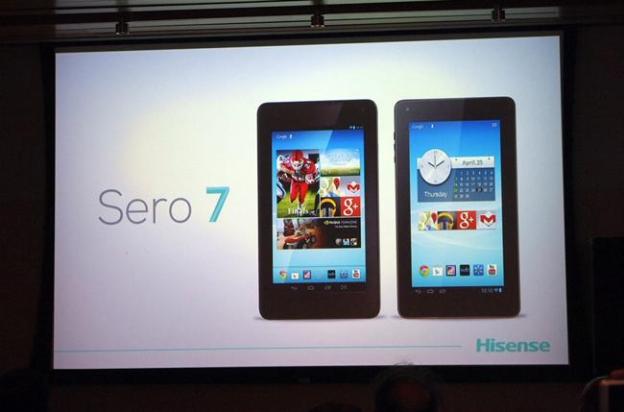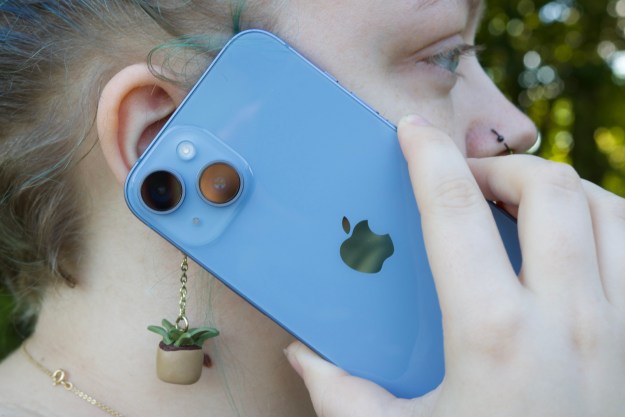
Just how low can 7-inch tablet prices go? After Google captured everyone’s imagination (and Benjamins) with a wildly popular $200 Nexus 7 tablet made by Asus last year, every tech company under the sun seems to have a me-too 7-incher at a similar price point. The latest company to join the jam-packed party is Hisense, the Chinese brand better known for the high-definition televisions you find at Walmart. In fact, the company is bringing its TV-making expertise to the mobile space with two 7-inch slates: the $100 Sero 7 LT (pronounced “light”) and $150 Pro. While these aggressively-priced slates are exclusive to Walmart, are they worth a trip to the mass retailer (or its website)? We got a closer look at these budget mini-tablets at Hisense’s press conference to help you decide.
Hisense Sero 7 Pro
There is no doubt Hisense is going after the Google Nexus 7 with the Sero 7 Pro tablet. When we held the device for the first time, we were struck by how similar its rubberized back cover felt to the Nexus 7 (complete with the logo stamped on the back), which makes the Pro comfortable to hold. It has a relatively thick bezel around its 7-inch IPS touch display, with the same 1280 x 800 pixel resolution as Google’s device. They even share many of the same components: both tablets are powered by the 1.3GHz quad-core Nvidia Tegra 3 processor, 1GB RAM, Bluetooth, Wi-Fi, NFC, and all the usual motion sensors. Both of them even run the same build of Android Jelly Bean (Android 4.2).
That said, the Sero 7 Pro also makes a number of improvements on the Nexus 7. For one thing, the flagship Hisense device features dual cameras, where you can take photos and videos with its rear 5-megapixel camera, while the front 2-megapixel cam can handle video chats. It also offers a microSD card slot that is protected by a swivel door, making it easy to sideload content or expand its 8GB of internal storage. You can also plug this tablet directly into a HDTV with a HDMI cable, but you’ll need an adapter as the socket on the tablet is just a Mini HDMI-out. All its ports and slots are located along the top edge of the tablet, with the power and volume rocker on the right, which means your wires won’t get in the way if you are propping the slate up on a stand in portrait mo

As a Tegra 3-powered tablet, the Sero 7 Pro is preloaded with the TegraZone app that highlights all the Android games that show off what the device can do. One of the newer mobile titles that John Lonergan, Nvidia’s VP of sales and marketing of the Americas, demoed on stage was Beach Buggy Blitz (pictured below on a Sero 7 Pro plugged into a Hisense HDTV). He was able to crash into obstacles in the game, which immediately changed the shadows on the track – a feature unique to Tegra technology.

While the Sero 7 Pro should benefit from the “fifth battery saver core” of the Tegra 3 architecture, it does pack a smaller battery than the Nexus 7: it has a 4000mAh battery versus the slightly more powerful 4325 mAh inside the Google slate. That said, Hisense is promising about 10-hours of Web browsing on the Sero 7 Pro. We’ll have to put the Pro’s battery life to the test once we can get a unit into our labs for review.
Hisense Sero 7 LT

Just what kind of tablet can you get for $100? With the Sero 7 LT, you’re looking at a device with more modest components than its flashier twin, the Pro. They look like identical twins from the front, but you’ll notice the difference once you pick up the LT. The cheaper Sero is noticeably lighter than the Pro, as its name suggests, and doesn’t have the textured back that makes the Pro so comfortable to hold. In fact, the LT has a smooth metal back cover that looks like a shimmery shade of brown.

Its Power button and Volume rocker are also along the left side of the slate, so if you’re used to having those buttons on the right like with the Pro, then the LT will take some adjustment. They also share the same ports like Micro USB, Mini HDMI, audio jack, and microSD card slot along the top edge of the tablet, the only difference being that the card slot doesn’t have a little door protecting it from dust.
Hisense is also able to keep the LT affordable by cutting corners on some of the components inside the slate. For example, its 7-inch touchscreen is non-IPS and has just 1024×600 pixel resolution, which is certainly good enough for basic Web surfing and Facebook but will hardly challenge the iPad’s Retina display for image sharpness. It also uses an unnamed 1.6GHz dual-core processor rather than the Nvidia chip that powers the Pro, offers just 4GB of internal storage (versus 8GB in the Pro), has just one front-facing 0.3-megapixel camera, and runs an older version of Android Jelly Bean (Android 4.1) than the Pro. That said, the LT still has most of the same guts as the Pro: 1GB RAM, Wi-Fi connectivity, as well as stereo speakers.

Perhaps the most significant disadvantage of the $100 LT is that it packs a smaller battery (3400mAh) than its brother (4000mAh), so don’t expect the LT to last more than the length of two movies before it needs to be plugged in. Although the smaller internal battery is part of the reason the LT model weighs less than the Pro, we would much rather haul around a slightly heavier device for its longer-lasting battery. We’ll have to test the LT more thoroughly to see if its battery life is really as short as Hisense claims. If so, it might be worth the extra $50 to get the Tegra 3-powered, quad-core Sero 7 Pro for its bigger battery alone.
If you want a $100 Android tablet, the Hisense Sero 7 LT is definitely a solid choice. The fact that it has a microSD slot means its 4GB of on-board storage is not too much of a deal breaker, as you can always expand the slate’s storage capacity through a microSD card. However, its short battery life due to its smaller internal battery is the bigger issue, which may make it smarter to splurge an extra $50 for the more energy efficient, yet more powerful, Sero 7 Pro.
Both devices are now available online and in stores across the country. Let us know how you like it!



